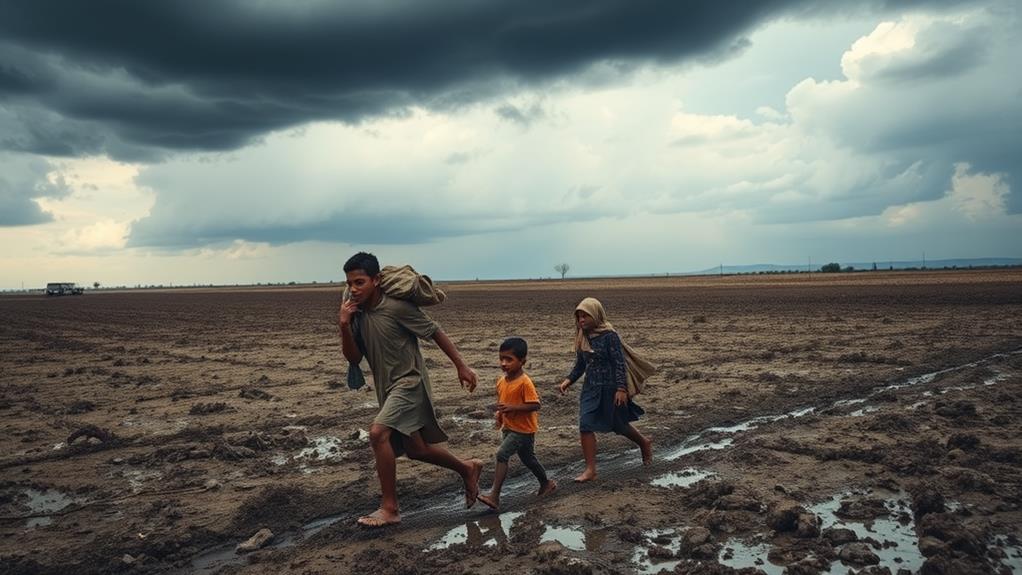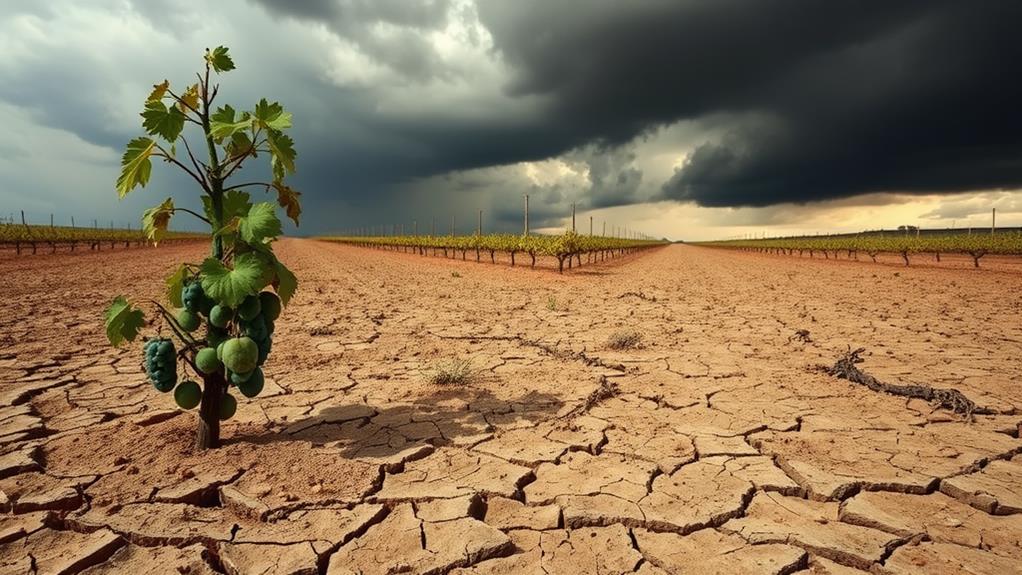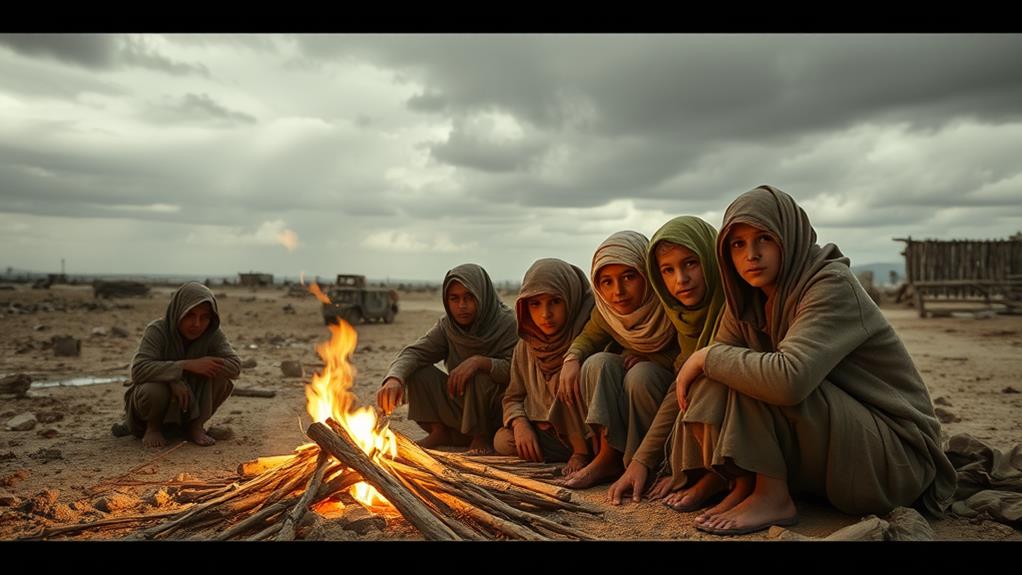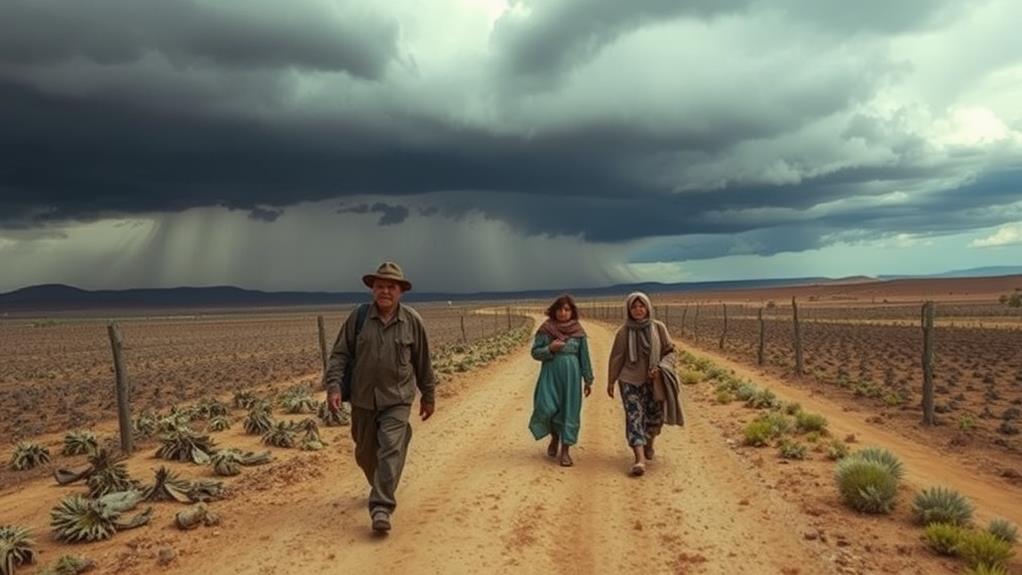*The Grapes of Wrath* remains relevant because it highlights struggles that mirror today's social injustices. You'll see the Joad family's resilience in the face of poverty and discrimination, emphasizing the importance of community support and unity. Steinbeck's critique of the American Dream and the exploitation faced by migrant workers resonates strongly with current economic disparities. The themes of dignity in adversity and the quest for justice offer powerful lessons that inspire action against systemic oppression. There's more to discover about how Steinbeck's work continues to shape our understanding of these issues in today's world.
Steinbeck's Literary Journey
John Steinbeck's literary journey is deeply rooted in his early life and the socio-economic shifts of his time. Growing up in Salinas, California, you can see how his experiences shaped his empathy for marginalized communities. The industrialization, World War I, and the Great Depression influenced Steinbeck's commitment to exposing social injustices through his writing.
His work poignantly illustrates the struggles of migrant workers, highlighting themes of social injustice and economic inequality. As you read his works, you notice how he captures the struggles of the working class, advocating for their rights and dignity.
His masterful storytelling combines realism with evocative prose, drawing you in and making you feel the harsh realities of life during his era. Steinbeck's insights into economic hardship resonate with readers, connecting them to the fundamental aspects of the human condition.
You can't help but appreciate how his themes of resilience and community highlight the importance of standing together against adversity.
Even today, Steinbeck's exploration of social justice and the plight of the working class holds enduring relevance. His ability to portray the struggles and triumphs of ordinary people invites you to reflect on the ongoing issues in society, making his work timeless and impactful.
Overview of The Grapes of Wrath
Steinbeck's exploration of social injustices culminates in "The Grapes of Wrath," a powerful narrative that follows the Joad family's desperate journey from Oklahoma to California during the Great Depression and Dust Bowl.
This novel vividly portrays the struggles faced by migrant workers, emphasizing their fight against poverty and social issues that threaten their dignity and survival. Much like Louis Zamperini's survival story in the triumph of the human spirit, the Joads exemplify resilience in the face of overwhelming adversity.
As the Joads traverse the harsh landscape, you witness their resilience in the face of overwhelming adversity. Steinbeck masterfully uses imagery and immersive storytelling to capture the despair and challenges experienced by displaced families.
The Joads' journey to California represents the pursuit of the American Dream, yet Steinbeck critiques this ideal, revealing the stark realities of exploitation and inequality that often accompany such aspirations.
Published in 1939, "The Grapes of Wrath" won the Pulitzer Prize and remains a classic of American literature. It continues to resonate in discussions of social justice and economic disparity, reminding you of the ongoing relevance of its themes.
Steinbeck's work urges you to reflect on the struggles of those who seek a better life, making it an enduring narrative of courage and hope.
Themes of Struggle and Resilience

In "The Grapes of Wrath," you witness the Joad family's unwavering dignity as they confront immense challenges on their journey.
Their story highlights how community support systems become a lifeline, reminding you that strength often lies in unity.
The novel's exploration of social injustice and economic hardship social injustice and economic hardship adds a poignant layer to their struggle.
As you explore these themes, you can't help but reflect on the resilience required to face adversity today.
Dignity in Adversity
Maneuvering the harsh realities of poverty and discrimination, the Joad family in "The Grapes of Wrath" embodies the theme of dignity in adversity. Their journey during the Great Depression highlights the struggles and resilience of the human spirit, showcasing how they maintain their sense of self-worth despite overwhelming socio-economic issues.
The Joads face systemic oppression and exploitation, yet they refuse to let these challenges strip them of their dignity. Tom Joad's determination to fight for justice serves as a powerful reminder of the strength found within the human spirit.
As the family navigates their hardships, they rely on each other and their shared experiences, illustrating the essential role of communal support in overcoming adversity. Steinbeck emphasizes that even in the direst circumstances, marginalized communities can endure and adapt, seeking dignity in every small victory.
Ultimately, "The Grapes of Wrath" portrays the profound importance of maintaining dignity amidst struggle. The Joads' resilience becomes a symbol for anyone grappling with adversity, reminding us that the pursuit of dignity is a universal endeavor that transcends time and circumstance.
Community Support Systems
Community support systems play a significant role in the survival and resilience of the Joad family in "The Grapes of Wrath." As they encounter the harsh realities of the Great Depression, the bonds they form with other migrant families become essential for overcoming adversity.
The novel illustrates how community support fosters strength in the face of hardships. When the Joads and fellow migrants share resources, they create a network of solidarity that helps everyone endure the struggle against exploitation.
Tom Joad's powerful assertion, "I'll be everywhere—wherever you can look," emphasizes that the spirit of community extends beyond individual suffering. Through shared meals and stories, the migrants find hope and encouragement, reinforcing their collective resilience.
This camaraderie is essential as the narrative highlights their attempts to organize labor strikes, advocating for better working conditions and fighting against the systemic injustices they face.
In these moments, you see how community becomes a lifeline for the Joads and others, illustrating that together, they can confront the overwhelming challenges of their time.
Ultimately, the strength found in these support systems remains a poignant reminder of the power of unity in the face of adversity.
Impact of the Film Adaptation
While the film adaptation of "The Grapes of Wrath" by John Ford has achieved critical acclaim, its impact extends far beyond accolades and box office success. Released in 1940, the film captured the emotional depth of Steinbeck's narrative, vividly illustrating the hardships faced by the Joad family during the Great Depression.
Henry Fonda's portrayal of Tom Joad resonated with audiences, solidifying his status as a leading actor of the era. The film's portrayal of collective struggle and resilience echoes the themes of solidarity found in various historical resistance movements, demonstrating that the fight for justice and dignity is a timeless endeavor. Additionally, it emphasizes the importance of community support in overcoming adversity, reminiscent of how acts of courage and defiance were pivotal during World War II.
The film's powerful visuals and poignant performances not only entertained but also educated viewers about pressing social issues. By bringing the Joad family's struggles to life, the adaptation enhanced global awareness of the struggles faced by many during that tumultuous time.
However, it's crucial to note that some critics argue the film lacks the broader societal critique found in Steinbeck's original work. While the adaptation effectively conveys the emotional weight of the story, it may not fully encapsulate the complex social commentary that the novel offers.
Ultimately, the film adaptation of "The Grapes of Wrath" remains significant, sparking conversations about the ongoing relevance of its themes in today's society.
Legacy of Steinbeck's Work

As readers immerse themselves in John Steinbeck's *The Grapes of Wrath*, they quickly discover why this novel stands as a cornerstone of American literature. Steinbeck's poignant exploration of the human condition during the Great Depression lays bare the struggles against economic disparities and social injustice.
The themes of resilience and community resonate deeply, encouraging you to contemplate the importance of empathy and collective action in confronting systemic oppression. Much like the stories shared by successful Australian women who face adversity, Steinbeck's characters embody the courage and determination required to overcome life's challenges, revealing the transformative power of hope and unity through shared narratives.
The legacy of *The Grapes of Wrath* extends beyond its pages, influencing artists, activists, and thinkers who endeavor for social justice. Its vivid portrayal of hardship and hope inspires ongoing dialogue about equity and the responsibilities we hold toward one another.
Steinbeck's ability to weave realism with evocative prose captivates readers, prompting introspection about societal roles and accountability. This novel not only captured a specific era but also serves as a timeless reminder of the power of unity in the face of adversity.
As you engage with Steinbeck's work, you connect with a legacy that challenges you to reflect on your role in addressing contemporary issues of inequality and injustice.
Social Injustice and Modern Relevance
Frequently, readers find themselves struck by the relevance of *The Grapes of Wrath* in today's society, where social injustices persist and inequality remains a pressing issue. The Joad family's struggles highlight the harsh realities of poverty and inequality, reflecting a modern landscape filled with systemic oppression.
As you explore Steinbeck's narrative, you can't help but recognize the parallels between the Joads' journey and the challenges faced by marginalized communities today. Engaging narratives, like those found in captivating science stories, can further enhance your understanding of these issues.
Income disparity and the plight of migrant workers echo the same themes of struggle and resilience. Steinbeck emphasizes the importance of community and collective action, encouraging you to engage in solidarity against these injustices. This call to action can inspire you to confront the systemic inequalities that plague our society.
Moreover, the juxtaposition of hope and despair in the novel underscores the ongoing fight for dignity and equity. By fostering empathy and awareness, you can contribute to current movements advocating for social justice and workers' rights.
Ultimately, the modern relevance of *The Grapes of Wrath* serves as a reminder that the fight against social injustice is far from over, urging you to take a stand.
Symbolism in The Grapes of Wrath

In "The Grapes of Wrath," symbolism plays an essential role in highlighting hope and the struggle against nature's challenges.
You'll notice how elements like the letter and the turtle embody resilience and the desire for a better future, even as despair looms. Much like Liesel's love for books in the face of evil, these symbols reflect the human spirit's ability to endure through tough times.
Nature itself, represented through wind and color, reflects both the harsh realities and the enduring spirit of the Joad family's journey.
Symbolic Representation of Hope
The Joad family's journey in "The Grapes of Wrath" is rich with symbols that embody hope amidst adversity. Despite the hardships faced, these symbols reflect the characters' resilience and determination to overcome social injustices. As you investigate the narrative, you'll discover how these representations of hope persist through their struggles.
- The Turtle: Symbolizes the relentless progress of the working class, showcasing their perseverance despite obstacles.
- The Color Red: Represents both anger and hope, illustrating the characters' frustration with social injustices while igniting their determination to aim for a better future.
- Wind: Acts as a dual symbol, depicting destruction yet offering the potential for renewal, mirroring the cyclical nature of hope and suffering.
Steinbeck deftly juxtaposes hope with suffering, highlighting the ongoing struggle for dignity and identity.
As you explore the characters' experiences, you gain a deeper understanding of their aspirations and the relentless spirit that drives them forward.
The symbolic representation of hope in "The Grapes of Wrath" serves as a powerful reminder of the human capacity for perseverance in the face of adversity.
Nature's Role in Struggle
Nature plays an essential role in illustrating the struggles faced by the Joad family and their fellow migrants in "The Grapes of Wrath." Steinbeck vividly portrays the environment as both a formidable adversary and a source of hope. The dust storms symbolize the harsh realities and hardships the Joads endure, stripping away their dreams and livelihoods.
However, the soil also represents their aspirations for a better life, embodying fertility and growth that starkly contrasts with their current plight.
The turtle serves as a powerful symbol of resilience, embodying the determination of the working class to persevere despite overwhelming obstacles. Its slow, steady movement reflects the Joads' relentless struggle to keep moving forward.
Steinbeck's use of biblical imagery further enhances this theme, likening the Joads' journey to that of the Israelites, with the land representing a Promised Land filled with hope.
Ultimately, Steinbeck emphasizes the cyclical nature of life and the environment, illustrating the interconnectedness of struggle and hope. As the Joads face nature's wrath, they also cling to the possibility of renewal, showcasing the enduring strength of the human spirit in the face of adversity.
Scholarly Perspectives and Critiques
Critics have long engaged in a vibrant discourse surrounding "The Grapes of Wrath," examining its portrayal of social issues and the emotional weight it carries. Steinbeck's powerful narrative prompts debate over its empathy in depicting poverty versus the bleak representation of society. Some scholars, like Alfred Kazin, praise its epic grandeur, while others argue it's politically biased and overly sentimental.
The themes of resilience and personal growth found in other literary works, such as Charles Dickens' David Copperfield, resonate throughout the discourse, highlighting the universal struggles faced by individuals in dire circumstances.
Key points of scholarly critique include:
- The Christ-like character arc of Jim Casy and its allegorical elements, highlighting themes of sacrifice and redemption.
- The novel's impact on contemporary culture, inspiring artists such as Woody Guthrie and Bruce Springsteen.
- Ongoing discussions about its historical accuracy, with alternative narratives like Sonora Babb's "Whose Names Are Unknown" offering fresh perspectives on similar social and economic issues.
Contemporary critiques often focus on the emotional depth and political radicalism of the work, reflecting its continued relevance in today's sociopolitical landscape.
The Role of Community in Adversity

In times of hardship, communities often emerge as essential lifelines, and "The Grapes of Wrath" powerfully illustrates this truth through the Joad family's journey. As the Joads encounter other migrant families, you see how important communal support becomes in overcoming the relentless hardships of the Great Depression. Much like the intricate plotting and rich historical detail found in novels such as The Daughters of Night, these shared experiences foster a deep sense of resilience and compassion among the marginalized.
Steinbeck highlights the significance of community gatherings and shared resources, showcasing the power of collective action against social inequalities. The Joads and their fellow migrants unite, forming bonds that transcend individual struggles. This unity not only provides emotional support but also strengthens their fight for dignity and rights in a world that often neglects them.
The novel serves as a reminder that, even in the darkest times, the potential for compassion and cooperation can ignite hope. The Joads' journey emphasizes that forming communities is essential for survival, demonstrating that you can tackle systemic injustices more effectively together.
In today's world, this message remains relevant, urging you to recognize and nurture the communities around you in the face of adversity.
Conclusion
In the face of relentless hardship, *The Grapes of Wrath* reminds us that hope can bloom even in the harshest landscapes. As you reflect on Steinbeck's timeless tale, consider how the struggles of yesterday resonate with the challenges we face today. Just as the Joads forged their path through despair, we too can find strength in our shared humanity. Ultimately, it's our collective resilience that turns the bitter grapes of life into a sweet harvest of hope.



